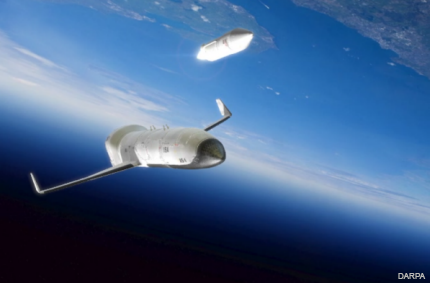3 companies get contracts for a satellite-launching space plane
DARPA’s XS-1 program aims to develop a hypersonic unmanned craft that can launch payloads from suborbital altitudes.

An artist's concept of the XS-1.
The Defense Advanced Research Projects Agency has awarded contracts to three company teams to begin developing prototypes of a reusable satellite launch vehicle that could make putting satellites into orbit easier, more routine and—critically—less expensive.
The agency’s Experimental Spaceplane, or XS-1, program aims to develop a modular, unmanned hypersonic plane that could fly to suborbital altitudes, use an expendable module to deploy a satellite into Low-Earth Orbit and then return. The agency has released a concept video for the program.
The teams awarded contracts for Phase 1 of the program are Boeing, working with Blue Origin; Masten Space Systems, working with XCOR Aerospace; and Northrop Grumman, working with Virgin Galactic, DARPA said in an announcement. Phase 1 is intended to assess the feasibility of the XS-1, as the teams develop a demonstration model, identify core technologies and risk-reduction plans, and come up with a schedule for developing and, eventually, flight-testing the XS-1.
The military uses a lot of satellites, but some launches have to be planned years ahead of time and can cost hundreds of millions of dollars when accounting for all the infrastructure and personnel required, DARPA said. Even small payloads can involve months of planning and significant costs. The Pentagon wants greater flexibility in launching small satellites for surveillance and other tasks and hopes to be able to do it for less money.
The XS-1 would be one way to achieve that. The program’s goals include developing a plane that could fly up to 10 times in 10 days, be capable of speeds in excess of Mach 10, and deliver a 3,000-to-5,000-pound payloads for less than $5 million a flight.
In DARPA’s vision, the XS-1 would be a reusable unmanned vehicle with expendable upper stages that could be attached as needed. Once it reaches a suborbital altitude, the expendable upper stage (or more than one, if necessary) would detach and deploy a satellite. The XS-1 would then return to Earth to be readied for its next flight.
If the program is successful, DARPA said, the technologies developed for the XS-1 could also benefit civilian agencies and commercial users, as well.
Reusable satellite launchers have been a goal of the military, NASA and other organizations for some time, as they look at less expensive ways of putting things into orbit. Another DARPA program, Airborne Launch Assist Space Access, or ALASA, is designed to develop an aircraft that can launch small satellites from more typical high-flying altitudes. The agency earlier this year awarded Boeing a contract to begin work on the project, with a goal of launching 100-pound payloads for less than $1 million per launch.
didn’t go so wellNEXT STORY: Air Force mulls secretive sensor research center